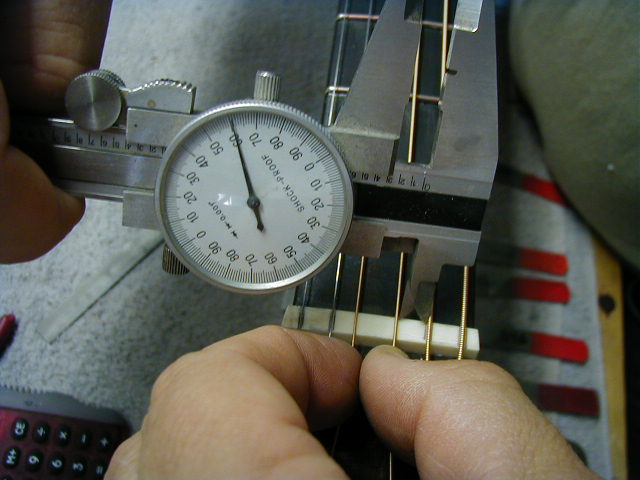At this point, we've got the E's set and it's time to start
setting the other strings.
 |
First, I use the "inside diameter" part of my calipers
to measure the inside distance between the E's. |
 |
We come up with 1.430" between the E's. Now it's
time for math. I'm using medium gauge strings and the A, D, G, B
strings add up to .046 + .036 + .026 + .017 = .125". Subtract:
1.430 - .125" = 1.305. There are 5 spaces between the E's, so
1.305/5 = 0.261. This is the distance I want between the remaining
strings.
I have a little chart on the
wall on which I've already added up medium, light, mandolin, and .010
electric strings. I do this so often that I pretty much have it
memorized and it's a 10 second process to punch the numbers into a
calculator. |
 |
The calipers are now set and locked to 0.261" |
 |
Using the inside jaws, it's an easy matter to rest the
calipers against the E and let the A string slide over until it just
touches. I'm using my thumb to control the A string. The B
is already set in this picture. I'm going to hold the A in place
and mark both sides with a mechanical pencil just like I did when
setting the E's. |
 |
Here's the marks for the A and B strings. You can
also see how the E's are centered in-between their pencil marks. I
like this method better than marking the center of the string because I
can still my marks once the strings are set. When you mark the
center of the string and then file on that, you lose your mark.
It's just one of those "that's the way ah've all-wus done it" things.....
:) |
 |
With the A and B set, it's time to set the remaining
two strings. I'm careful to check all 3 remaining measurements- A/D,
D/G, G/B before I mark and cut them. If I'm off at this point,
it's much easier to fudge the A or B over as appropriate than it is to
get done and find out I mis-set some strings. If the A or B needs
to scoot over just a little bit, I've got enough room on the nut that I
can file the groove at an angle, get it almost there, sand the excess
nut top off, and then straighten the groove up in the final touch-up.
You'll see what I mean later on.... |
 |
Checking the B/G relationship. I'm holding the D
in place with my thumb and the G with my index finger. There is
some tension on the strings- enough to make them want to "snap" out
toward the edges of the nut, thus I just have to apply counter-pressure
to hold them. |
 |
With the D and G spaced from the A and B, respectively,
I'd better have the correct distance remaining between the D and G.
I'm not going to obsess about .001 or so, but I should have everything
pretty close at this point. If I need to, I'll move the D and G a
little until I have a consistent feel between all the strings. I
would rather have a little less between the thinner B and G and a little
more between the thicker A and D than vice versa. But, I really
want it spot on....
When I'm happy with the spacing, I'll mark the strings with the
mechanical pencil. |
 |
D and G are marked and ready for filing. |
 |
All the strings are set in place. At this point, I'll
go back over everything with the calipers and double check. Now's the
time to decide if one string needs to be moved just slightly or not.
As you can see here, this nut is spaced pretty nicely. All my
pencil marks are still visible, showing that I cut the string into the
space where it's supposed to be. The E's are both angling just
slightly toward the inside of the peghead. Things look good.
Time to finish up. |
|
|
|